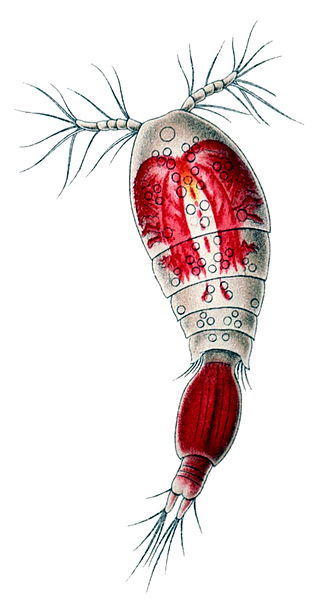
Diaptomus is a genus of copepods with a single eye spot. It is superficially similar in size and appearance to Cyclops. However it has characteristically very long first antennae that exceed the body length. In addition, the females carry the eggs in a single sac rather than the twin sacs seen in Cyclops. It is a copepod of larger freshwater ponds, lakes and still waters.
Boeckella is a genus of copepods in the family Centropagidae.

The Cyclopidae are a family of copepods containing more than half of the 1,200 species in the order Cyclopoida in over 70 genera.

George Stewardson Brady was a professor of natural history at the Hancock Museum in Newcastle-upon-Tyne who did important volumes on Copepoda and Ostracoda, including those from the Challenger expedition.

Oncaea is a genus of copepods. The genus contains bioluminescent species. Unlike other bioluminescent copepods, Oncaea have an internal (non-secreted) bioluminescence. Oncaea contains the following species:

Acartia is a genus of marine calanoid copepods. They are epipelagic, estuarine, zooplanktonic found throughout the oceans of the world, primarily in temperate regions.

Wilhelm Giesbrecht (1854–1913) was a Prussian zoologist, specialising in copepods, during the "golden age of copepodology".
Centropagidae is a family of copepods in the order Calanoida. Its members are particularly known as plankton in coastal waters and in fresh water in Australia and southern South America. They are also found on subantarctic islands and in lakes in Antarctica.
Phaennidae is a family of planktonic copepods, found in pelagic or benthopelagic waters. It contains the following genera:

Pontella is a marine copepod genus in the family Pontellidae. It is an organism that bears three lenses in the eye. The outer has a parabolic surface, countering the effects of spherical aberration while allowing a sharp image to be formed.
Augaptilidae is a family of copepods.

Mormonillidae is a family of planktonic marine copepods, the only member of the order Mormonilloida. There are five known species in two genera:

The clade Multicrustacea constitutes the largest superclass of crustaceans, containing approximately four-fifths of all described crustacean species, including crabs, lobsters, crayfish, shrimp, krill, prawns, woodlice, barnacles, copepods, amphipods, mantis shrimp and others. The largest branch of multicrustacea is the class Malacostraca.

Temora is a genus of copepods in the family Temoridae. The World Register of Marine Species lists the following species:
Oithona is a planktonic crustacean genus found in marine, brackish, fresh water environments. Oithona has been described as the most ubiquitous and abundant copepod in the world's oceans. It was first described by Baird in 1843 using the species Oithona plumifera as taxon type.

Eurytemora is a genus of copepods in the family Temoridae. The World Register of Marine Species lists the following species:

Leptodiaptomus is a genus of copepods belonging to the family Diaptomidae.
Heterorhabdidae is a family of copepods belonging to the order Calanoida.
Aetideidae is a family of copepods belonging to the order Calanoida.
Arietellidae is a family of copepods belonging to the order Calanoida.












